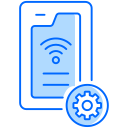IoT Protocols and Platforms for Mobile Applications
Chosen theme: IoT Protocols and Platforms for Mobile Applications. Build confident, resilient mobile experiences that connect devices, data, and people—securely, efficiently, and at scale. Explore practical insights, real-world stories, and field-tested techniques to transform raw telemetry into delightful, dependable app moments your users will love.
Choosing the Right Protocol for Mobile IoT
MQTT shines for persistent, low-overhead, bidirectional communication, especially when connections flap and radios sleep. HTTP is ubiquitous and tooling-rich but heavier per request. For mobile apps, MQTT’s keep-alives, QoS, and retained messages often reduce battery drain and data usage while enabling instant device-to-app updates and commands.

Platforms That Power Mobile IoT Apps
AWS IoT Core offers secure device messaging, Device Shadows for state sync, and fine-grained IAM policies. For mobile, combine Cognito for auth, IoT rules for routing, and AppSync or API Gateway to expose curated streams. Developers appreciate predictable scale, while users enjoy consistent, low-latency updates across spotty coverage.

Security from Device to App
Mutual TLS ensures both device and server prove identity using X.509 certificates. On mobile, pin public keys to prevent man-in-the-middle attacks, rotate certs gracefully, and secure keystores. A field rollout avoided a major breach by pinning during a suspicious ISP incident, preserving user trust without any app downtime.
Security from Device to App
When users claim devices, OAuth 2.0 with PKCE binds identities safely. Use short-lived tokens, refresh flows, and scoped permissions. Deep links guide users through linking steps without confusion. This approach kept a smart-home app intuitive while preserving strict least-privilege controls across family accounts and shared device scenarios.
Security from Device to App
Mobile phones often act as gateways for nearby sensors. Use BLE Secure Connections, rotate keys, and minimize sensitive payloads. When bridging to cloud, encrypt end-to-end to avoid local eavesdropping. One cycling wearable project doubled trust by encrypting locally and deferring heavy uploads until a secure Wi‑Fi was available.

Offline-First Sync Patterns
Queue outbound commands locally, assign stable IDs, and replay idempotently. Cache critical device state with timestamps. Use exponential backoff, jitter, and bounded retries. A fleet maintenance app cut support tickets by 40% after adopting offline-first UI patterns that clearly showed queued actions and pending acknowledgments.

QoS, Retries, and Ordering Guarantees
MQTT’s QoS 1 or 2 can ensure delivery despite drops, but duplicates will happen. Include sequence numbers and deduplication. Keep payloads small and composable. Ordering is best-effort; the app should tolerate slight reordering and reconcile state using timestamps, vector clocks, or last-write-wins policies based on your domain.
Simulators and Digital Twins
Create device simulators that model flapping networks, clock drift, and malformed payloads. Digital twins mirror live states for safe experimentation. A startup crushed onboarding bugs by testing against scripted edge cases in CI, catching inconsistent reconnection logic before users ever experienced confusing, frozen dashboards.
Mobile Telemetry and Crash Analytics
Instrument with privacy-conscious analytics, logs, and crash reporting. Log connection events, QoS metrics, and sync durations. Aggregate by app version and device model to spot regressions. In one release, a single misconfigured keep-alive interval surfaced immediately through dashboards, enabling a same-day hotfix that restored battery performance.
End-to-End Tracing and Correlation
Propagate trace IDs from device to cloud to mobile, then visualize with OpenTelemetry. Correlate a user’s button tap with device acknowledgments and database writes. This visibility shortens incident diagnosis and builds confidence, especially when an intermittent cellular region or proxy introduces subtle latency spikes.
Stories from the Field
Drivers needed instant updates without draining phones. By tuning MQTT keep-alives to match carrier NAT timeouts and batching location deltas, the team kept dashboards live. Support calls fell, and drivers reported smoother routes, with batteries lasting entire shifts even in congested downtown corridors.


Stories from the Field
Installers faced fragile Wi‑Fi and quirky routers. Introducing CoAP-to-HTTP proxies at the edge stabilized traffic and simplified cloud ingestion. DTLS session resumption cut setup time. Customers noticed only that everything felt snappier—scenes triggered reliably, and the app reflected device states almost instantly after pairing.
